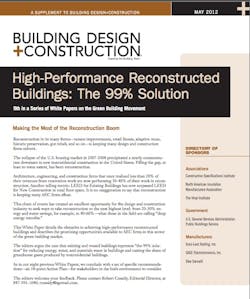2012 White Paper: High-Performance Reconstructed Buildings: The 99% Solution
Reconstruction in its many forms—tenant improvements, retail fitouts, adaptive reuse, historic preservation, gut rehab, and so on—is keeping many design and construction firms solvent.
The collapse of the U.S. housing market in 2007-2008 precipitated a nearly commensurate downturn in new nonresidential construction in the United States. Filling the gap, at least to some extent, has been reconstruction.
Architecture, engineering, and construction firms that once realized less than 20% of their revenues from renovation work are now performing 30-40% of their work in reconstruction. Another telling metric: LEED for Existing Buildings has now surpassed LEED for New Construction in total floor space. It is no exaggeration to say that reconstruction is keeping many AEC firms afloat.
This chain of events has created an excellent opportunity for the design and construction industry to seek ways to take reconstruction to the next highest level: from 20-30% energy and water savings, for example, to 40-60%—what those in the field are calling “deep energy retrofits.”
This White Paper details the obstacles to achieving high-performance reconstructed buildings and describes the promising opportunities available to AEC firms in this sector of the green building market.
The editors argue the case that existing and reused buildings represent “the 99% solution” for reducing energy, water, and materials waste in buildings and cutting the share of greenhouse gases produced by nonresidential buildings.
As in our eight previous White Papers, we conclude with a set of specific recommendations—an 18-point Action Plan—for stakeholders in the built environment to consider.
The editors welcome your feedback. Please contact Robert Cassidy, Editorial Director, at 847-391-1040; [email protected].
Click here to download a PDF of High-Performance Reconstructed Buildings: The 99% Solution, the 9th in a Series of White Papers on the Green Building Movement
Chapter 1 Reconstruction: ‘The 99% Solution’ for Energy Savings in Buildings
Chapter 2 Exemplary High-Performance Reconstruction Projects
Chapter 3 How Building Technologies Contribute to Reconstruction Advances
Chapter 4 Business Case for High-Performance Reconstructed Buildings
Chapter 5 LEED-EB and Green Globes CIEB: Rating Sustainable Reconstruction
Chapter 6 Energy Codes + Reconstructed Buildings: 2012 and Beyond
Chapter 7 When Modern Becomes Historic: Preserving the Modernist Building Envelope
Chapter 8 High-Performance Reconstruction and Historic Preservation: Conflict and Opportunity
Chapter 9 The Key to Commissioning That Works? It Never Stops
Chapter 10 Action Plan: 18 Recommendations for Advancing Sustainability in Reconstructed Buildings
DIRECTORY OF SPONSORS
Associations
Construction Specifications Institute
North American Insulation Manufacturers Association
The Vinyl Institute
Government
U.S. General Services Administration Public Buildings Service
Manufacturers
Duro-Last Roofing, Inc.
SAGE Electrochromics, Inc.
Sika Sarnafil
